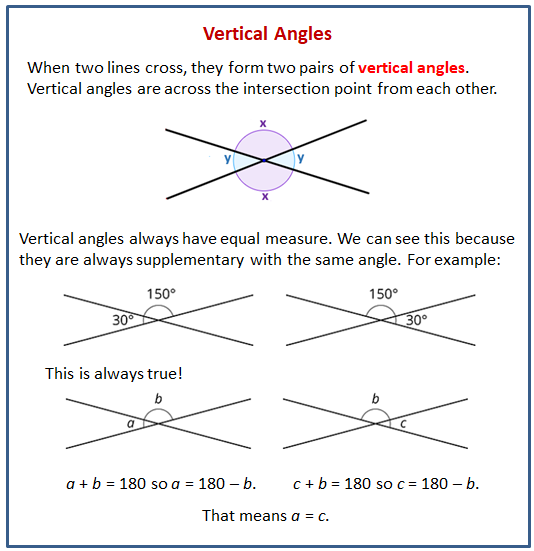Illustrative Mathematics Grade 7, Unit 7, Lesson 3: Nonadjacent Angles
Learning Targets:
- I can determine if angles that are not adjacent are complementary or supplementary.
- I can explain what vertical angles are in my own words.
Related Pages
Illustrative Math
Grade 7
Lesson 3: Nonadjacent Angles
Let’s look at angles that are not right next to one another.
Illustrative Math Unit 7.7, Lesson 3 (printable worksheets)
Lesson 3 Summary
The following diagrams explain what are vertical angles.

Lesson 3.1 Finding Related Statements
Given a and b are numbers, and a + b = 180, which statements also must be true?
a = 180 - b
a - 180 = b
360 = 2a + 2b
a = 90 and b = 90
Lesson 3.2 Polygon Angles
Use any useful tools in the geometry toolkit to identify any pairs of angles in these figures that are complementary or supplementary.
Lesson 3.3 Vertical Angles
Use a straightedge to draw two intersecting lines. Use a protractor to measure all four angles whose vertex is located at the intersection.
Compare your drawing and measurements to the people in your group. Make a conjecture about the relationships between angle measures at an intersection.
Lesson 3.4 Row Game: Angles
Find the measure of the angles in one column. Your partner will work on the other column. Check in with your partner after you finish each row. Your answers in each row should be the same. If your answers aren’t the same, work together to find the error and correct it.
Lesson 3 Practice Problems
- Two lines intersect. Find the value of b and c.
- In this figure, angles R and S are complementary. Find the measure of angle S.
- If two angles are both vertical and supplementary, can we determine the angles? Is it possible to be both vertical and complementary? If so, can you determine the angles? Explain how you know.
- Match each expression in the first list with an equivalent expression from the second list.
- Factor each expression.
- The directors of a dance show expect many students to participate but don’t yet know how many students will come. The directors need 7 students to work on the technical crew. The rest of the students work on dance routines in groups of 9. For the show to work, they need at least 6 full groups working on dance routines.
a. Write and solve an inequality to represent this situation, and graph the solution on a number line.
b. Write a sentence to the directors about the number of students they need. - A small dog gets fed 3/4 cup of dog food twice a day. Using d for the number of days and f for the amount of food in cups, write an equation relating the variables. Use the equation to find how many days a large bag of dog food will last if it contains 210 cups of food.
The Open Up Resources math curriculum is free to download from the Open Up Resources website and is also available from Illustrative Mathematics.
Try out our new and fun Fraction Concoction Game.
Add and subtract fractions to make exciting fraction concoctions following a recipe. There are four levels of difficulty: Easy, medium, hard and insane. Practice the basics of fraction addition and subtraction or challenge yourself with the insane level.

We welcome your feedback, comments and questions about this site or page. Please submit your feedback or enquiries via our Feedback page.